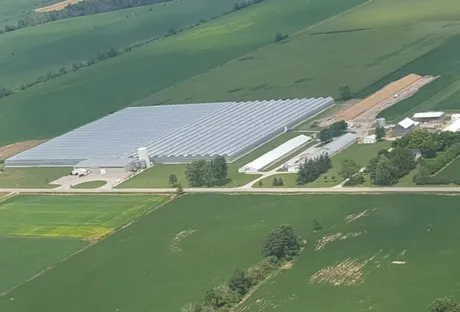When Jack Greydanus started cultivating peppers at Enniskillen Pepper in 2004, the average greenhouse operation in Canada was 6 acres, or 260,000 square feet. Now, almost 15 years later, the operation in Enniskillen, Ontario is almost double the size, but there's not a pepper plant in sight today. Last year, Jack leased his greenhouses to Tilray, a Canadian supplier of medical marijuana, so cannabis now grows where bell peppers were once picked.
In recent months, we've seen a lot of greenhouse vegetable growers in Canada make the switch to marijuana, and that's no surprise, given the million-dollar industry that cannabis is. "They pay a pretty honest dollar for the asset," as Jack points out.
"Hey, do you know anyone...?"
For Jack, it all started in December 2016, when a local development company approached him with the question if he knew anyone in the area who had a gas, water, and electric supply for a complex of 20 hectares. "So I started to look around, but I didn't know what they were looking for, just that they were looking for 40 acres."
They approached him again, now asking if he was interested in selling his greenhouse. At first he said no, but when he was approached again with the same request, he decided to put a price on his greenhouse. The investors took a look at the greenhouse, they liked what they saw, and a deal was made.
He's not personally involved with the day-to-day operations of the greenhouse now. Having leased the property, he basically acts as the 'landlord'. Tilray are in charge of the operation, and they've invested a tidy sum into getting it ready for cannabis cultivation: 20 million dollars.
7 acres of concrete, 300 cameras
For instance, Jack tells us Enniskillen Pepper worked with 16,000 square feet of warehouse space; the cannabis grower increased this to no less than 40,000 square feet. And according to Health Canada regulations, 7 acres had to be poured with concrete, and security measures had to be taken: the premises now has around 300 cameras.
The cannabis crop required some adjustments as well, in terms of cultivation technique. Instead of having strings hanging from the top of the greenhouse, cannabis plants are supported with wires in the plant itself. Also, while pipe rail heating is still used, the spacing had to be changed due to the new crop.
As for labor, the company's local staff were given the option to transfer over to the cannabis operation. The seasonal workers from the Caribbean, however, are not permitted by Health Canada to work with cannabis. Despite this seeming complication, plenty of marijuana companies are looking to invest in vegetable greenhouses.
The 10 percent
The switch from greenhouse vegetables to cannabis shows no signs of letting up. "I get calls quite frequently about what process I went through", Jack tells us. "One individual just north of here recently switched a 20-acre block to cannabis. So, it's continuing; I would say 5 percent of greenhouse vegetable growers in Ontario have now moved into cannabis."
Judging by the colleagues he knows who have made the switch, he estimates: "We've got about 2000 acres under glass here in Ontario, and I would suggest at least 100 have gone to cannabis; perhaps it's even as much as 200 acres." That's a whopping 10 percent of the total vegetable greenhouse acreage in the province.
Canada: a cannabis paradise?
Looking at the figures, it seems to be mostly Canadian growers who are making the switch. Why is this? Jack points to the upcoming legalization of cannabis, which is slated for this summer, as the main reason. But there are other factors that make Canada particularly fertile ground for cannabis corporations.
Another main driver is the ability for Canadian cannabis producers to export their produce to other countries. For instance, Tilray, the company that took over Jack's greenhouse, is currently exporting to Argentina, Australia, Chile, Croatia, Cyprus, Czech Republic, Germany, New Zealand, and South Africa.
And last but not least, Canada has an existing greenhouse infrastructure, complete with skilled labor, creating a 'perfect storm' for marijuana suppliers looking to expand their operations.
Substantial growth
Jack is still in agriculture, but he's moved away from greenhouses - he's quite happy running his poultry farm instead. "For the greenhouse industry, it's all about economies of scale. Minimum wage has moved up considerably, and the carbon tax in this country also causes high expenses."
So the operating costs for smaller greenhouses are on the rise, and Jack says that "if you want to stay long-term in this business, you have to increase your acreage." While he's not personally a part of that development, he does offer his view of how the industry will develop. "It's growing leaps and bounds. I would suggest that this year, Ontario alone will put up 110-120 hectares. It's substantial."
Sign up for our daily Newsletter and stay up to date with all the latest news!
Subscribe I am already a subscriber